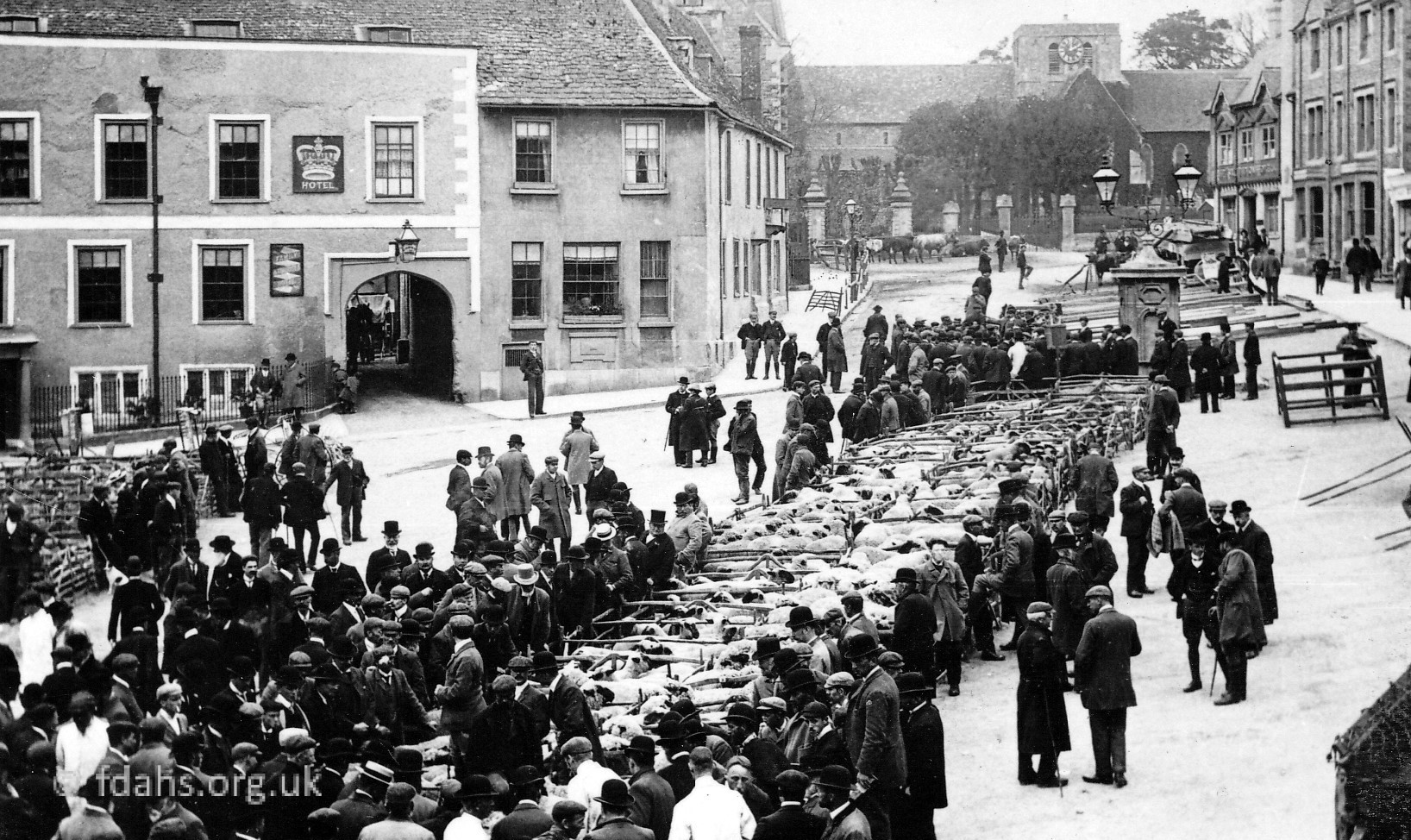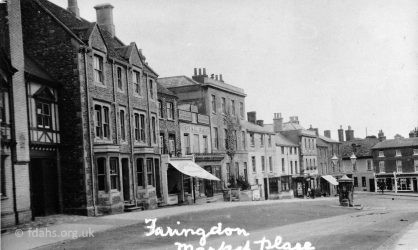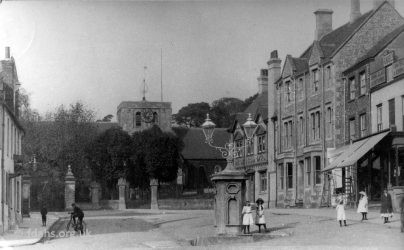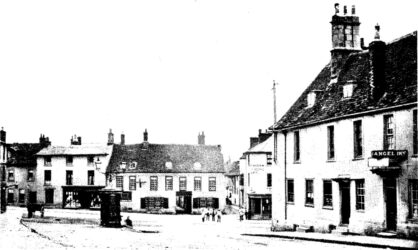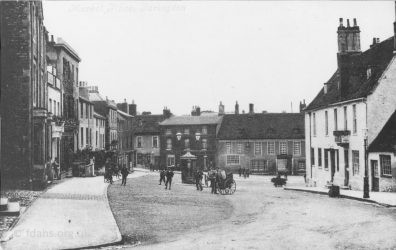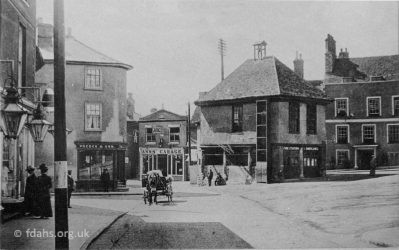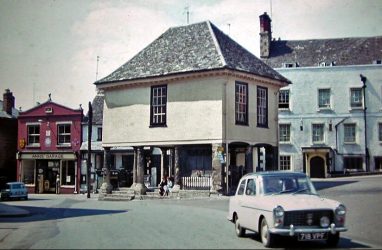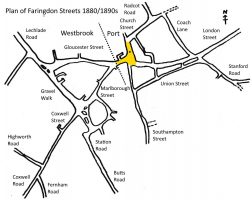 The town centre of Faringdon is divided into two separate areas as shown on the map – the Market Place (surrounding the Market Hall and extending up Church Street) and Cornmarket (a smaller area in front of the Corn Exchange).
The town centre of Faringdon is divided into two separate areas as shown on the map – the Market Place (surrounding the Market Hall and extending up Church Street) and Cornmarket (a smaller area in front of the Corn Exchange).
In 1551 the centre of Faringdon was referred to as Highe Strete als [alias] Chepe Strete. Later it became Market Place presumably because the market, a Charter being granted by Henry III in 1218, was held there. Part of it on Church Street however was referred to as Port Well in deeds of the late 18th and early 19th century.
Faringdon Market Place surrounds the Market Hall and actually begins at the corner of Church Street opposite the church. Postal addresses usually follow this area rather than the actual road names found on standard maps. The dotted line on the map shows the passage of a brook, which once divided Faringdon into the tithings of Port to the east, and Westbrook to the west. It used to be forded at this point but now passes under the road.
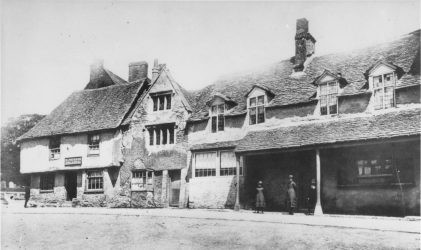 1880s. A very early photo showing the old buildings at the top of the Market Place before they were replaced in 1890. The church graveyard is just visible on the far left. From the left is R. Pettifer, the builder’s. Next comes a barber’s, shown by the barber’s pole outside the shop. Under the overhang was a sweet shop where the lady owner would serve customers through the window but wouldn’t allow them inside. These three buildings were demolished in 1890 and replaced with #1 an extension to the Salutation Hotel around the corner in Church Street, and #2 now occupied by Crowdy & Rose Solicitors.
1880s. A very early photo showing the old buildings at the top of the Market Place before they were replaced in 1890. The church graveyard is just visible on the far left. From the left is R. Pettifer, the builder’s. Next comes a barber’s, shown by the barber’s pole outside the shop. Under the overhang was a sweet shop where the lady owner would serve customers through the window but wouldn’t allow them inside. These three buildings were demolished in 1890 and replaced with #1 an extension to the Salutation Hotel around the corner in Church Street, and #2 now occupied by Crowdy & Rose Solicitors.
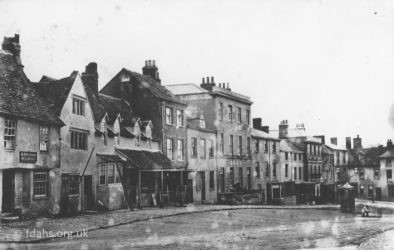 1880s. This photo, looking from the church down the east side of the Market Place starts with the same three buildings as above. The tall three-storey building in the centre is #5 the Pump House. What appears as four white squares above the ground floor windows are where the letters ‘BANK’ were chiselled out when the County of Gloucester Bank moved there. The building was then used as offices by the Eagle Brewery followed by a club for ex-servicemen before becoming the Community Centre. The building where there is a protruding window was Liddiard’s grocery stores (???). The Portwell can be seen on the right-hand side.
1880s. This photo, looking from the church down the east side of the Market Place starts with the same three buildings as above. The tall three-storey building in the centre is #5 the Pump House. What appears as four white squares above the ground floor windows are where the letters ‘BANK’ were chiselled out when the County of Gloucester Bank moved there. The building was then used as offices by the Eagle Brewery followed by a club for ex-servicemen before becoming the Community Centre. The building where there is a protruding window was Liddiard’s grocery stores (???). The Portwell can be seen on the right-hand side.
c1903 & pre1913. The same views a little later. The old buildings were replaced in 1890. Just visible on the left (or right in the second photo) is #1 an extension to the Salutation Hotel around the corner in Church Street, and #2 a new building that is still occupied today by Crowdy & Rose Solicitors. Mr Heavens, the butcher is at #3 with his name just visible on the awning. Next door at #4 was once F. Barnard’s, a general furniture warehouse & manufactory, who advertised in 1891 as a cabinet maker & upholsterer, also selling pianos, glass, china, earthenware. At this time it had been taken over by F.W. Cadel. Next is the old Pump House at #5, with the name ‘BANK’ above the windows now removed. At couple with a sack barrow can be seen on the steps of #7 Liddiard & Sons, the grocers. Next is #8 Lloyds Bank followed by another shop with an awning at #9, which is E.Lay, the baker. On the corner at #10 was possibly still Cooper’s, a chymist, who were there in the 1880s. Across the road, the rather plain shop is #2 London Street, labelled ‘Hunting & Livery Boot Maker’. It was previously run by C.H. Bevan but had been taken over by T.A. Pocock’s by this time. Next door is back in the Market Place at #11-12 and looks like it could be Arthur W. Smith’s, a draper shop.
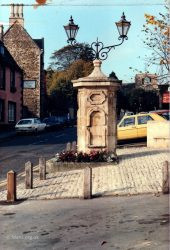
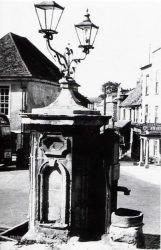 The Portwell, outside the front of the Pump House appeared very central in the Market Place in the above photograph. It was given to the town by Sir Henry Unton, Lord of the Manor in the 16th century. It was pumped from the spring which rises in the cellar of the Pump House. It was then the town’s only piped water supply. On one side there was a hand pump with a heavy lead drinking cup securely chained for people to use. There were also two troughs providing water for the horses and cattle that used the market. Two gas lamps were placed on top in the 19th century.
The Portwell, outside the front of the Pump House appeared very central in the Market Place in the above photograph. It was given to the town by Sir Henry Unton, Lord of the Manor in the 16th century. It was pumped from the spring which rises in the cellar of the Pump House. It was then the town’s only piped water supply. On one side there was a hand pump with a heavy lead drinking cup securely chained for people to use. There were also two troughs providing water for the horses and cattle that used the market. Two gas lamps were placed on top in the 19th century.
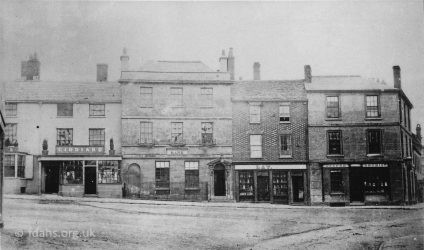 c.1880s. The buildings lower down on the east side of the Market Place, with London Street just visible on the far right. The entrance to Haines’ premises, who was a solicitor and also ran a postal lending library, was the doorway that can be seen just in London Street. From the left is #7 George Ernest, grocer and bacon curer; #7a Liddiard, grocer; #8 the County of Gloucester Bank; #9 Lay*, baker and confectioner; #10 Cooper, Chymist. On the far right is the start of London Street. Most of these buildings had a separate passageway, from the Market Place, to gain access to the living accommodation, plus one from Swan Lane to the buildings used for the storage of goods and the stabling of horses.
c.1880s. The buildings lower down on the east side of the Market Place, with London Street just visible on the far right. The entrance to Haines’ premises, who was a solicitor and also ran a postal lending library, was the doorway that can be seen just in London Street. From the left is #7 George Ernest, grocer and bacon curer; #7a Liddiard, grocer; #8 the County of Gloucester Bank; #9 Lay*, baker and confectioner; #10 Cooper, Chymist. On the far right is the start of London Street. Most of these buildings had a separate passageway, from the Market Place, to gain access to the living accommodation, plus one from Swan Lane to the buildings used for the storage of goods and the stabling of horses.
* Henry Lay (1815-1879) was born in Highworth and by the age of 25, he was living in London Street and become a baker and confectioner. Soon after he married local girl Eliza Judd (1822-1897) and by the age of 51 had 5 daughters and 6 sons. He took over the shop at 9 Market Place during the 1850s. In 1869 he bought a shop in the little town of Swindon, now expanding since the arrival of the Great Western Railway. He died ten years later and his young daughter Eliza Emily Lay (1858-1914) continued to run the shop in Faringdon. Employed there as a pastry cook was a young man called George Stafford Willis, born in Malta, and they were soon married. Hence, at some time later in the next century the shop was renamed Willis.
c.1870s & 1890s. The Market Place, photos taken in Church Street looking south towards the Bell in the centre background. The rather a poor quality photo on the left was crudely copied from an article by Jim Brown published in a local paper.2 However, the article includes this photo which shows the building on the corner with Southampton Street (centre background) that later became Pocock & Son’s tailor shop and then Barclays Bank, clearly labelled at this time as ‘Faringdon Clothing Mart’. The opposite corner is the Bell Hotel, which once served as a hospice for those in the care of the Cistercian monks who owned the manor. There is reported to be an opening to a tunnel beneath the hotel which provided the monks hidden access to the church – see Faringdon Tunnels. In the foreground on the far right, it also shows the location of the ‘Angel Inn’ at this side of the Crown Hotel building. The doorway to the left of the inn is the entrance to the Postal Telegraph Office and Post Office Savings Bank. In October 1869, the office was connected to the telegraph system, and the postmaster, Mr Pike, gave up one of his rooms for an open counter and public lobby. The post rising up past the eaves on the corner was a semaphore-type signal with three arms controlled by wires running through the pipe leading through the first window. This was the signal for the mail-carrying coaches that there was mail to collect. This was not Faringdon’s first post office – one in Southampton Street was thought to be the first.2
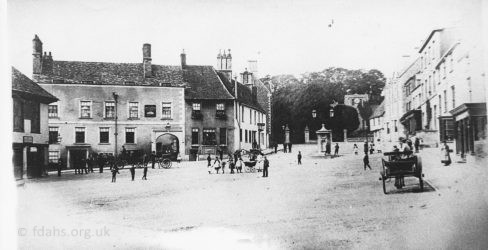 c.1890s. The Market Place looking north back up Church Street towards the church. On the left is the Town Hall with a board bearing the arms of George III between the windows. The lower board below advertises Thorley’s animal feeds. Behind the large doors were kept all the equipment, hurdles, posts and rails, for the weekly and monthly markets. In front of the Crown Hotel there is a one horse coach complete with a coachman in a top hat. In the archway is the hotel’s own handcart loaded with bags and a portmanteau. Next to the Crown is the Post Office with its signal post holding three coloured semaphore arms which were controlled by wires running in a tube. The Angel Inn is further up the street. The building at the top right belongs to Mr Pethers, the builder. This building was later incorporated into the Salutation Hotel. The old houses next to it have been replaced by the newly erected office of Mr Crowdy, the solicitor. The first shop at the right foreground is Mr Liddiard’s grocery store. The girls and ladies are all wearing the usual white pinafores or aprons while the men are in dark clothes. In the centre of the picture is a group of children by a pram, one is a blur as he or she was unable to keep still for the long exposure needed for the glass plate negative in the camera.
c.1890s. The Market Place looking north back up Church Street towards the church. On the left is the Town Hall with a board bearing the arms of George III between the windows. The lower board below advertises Thorley’s animal feeds. Behind the large doors were kept all the equipment, hurdles, posts and rails, for the weekly and monthly markets. In front of the Crown Hotel there is a one horse coach complete with a coachman in a top hat. In the archway is the hotel’s own handcart loaded with bags and a portmanteau. Next to the Crown is the Post Office with its signal post holding three coloured semaphore arms which were controlled by wires running in a tube. The Angel Inn is further up the street. The building at the top right belongs to Mr Pethers, the builder. This building was later incorporated into the Salutation Hotel. The old houses next to it have been replaced by the newly erected office of Mr Crowdy, the solicitor. The first shop at the right foreground is Mr Liddiard’s grocery store. The girls and ladies are all wearing the usual white pinafores or aprons while the men are in dark clothes. In the centre of the picture is a group of children by a pram, one is a blur as he or she was unable to keep still for the long exposure needed for the glass plate negative in the camera.
1913 & 1962. Turning to your left with your back to London Street. Note how the means of transport changed in those 50 years. In the first photo the bell of the Bell Hotel can be seen on the left. The Town Hall in the centre has had a chequered history and at one time was used as a lock-up for prisoners awaiting trial. The fire engine was kept underneath. Note the wooden framework on the side which was used for drying the hoses and the bell on the roof used for summoning the firemen. The Church bier was stored there and, during WWII, it was commandeered by the army for accommodating soldiers. In recent times it has variously been a meeting room, a library and finally a Red Cross Charity shop. The bell hanging outside the Bell Hotel can just be seen on the left of the picture. The gas lamps are hanging outside the draper’s shop. Further down on the left, at the junction with Southampton Street, is #14 Pocock, tailor, which later became part of Barclay’s Bank. Visible in both photos, across the junction with Marlborough Street to the left of the Town Hall is #22 Ann’s Garage. It used to be Joseph Newman (blacksmith) from 1877. The building was demolished and replaced in 1910 to build the garage. Later it was taken over by Busby, newsagents, and has changed ownership but not use four times since. Part of the Crown Hotel is to the right of the Town Hall.
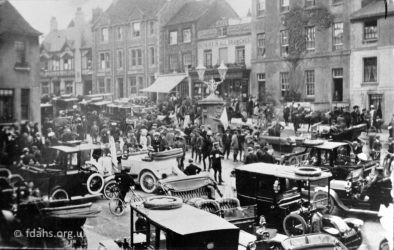 1911. An early traffic jam in the Market Place with the Town Hall just visible on the left. Lots of London taxis, those with a spare tyre on the roof, had brought many foreign military attaches to Faringdon to observe Army manoeuvres. The Prime Minister, Mr Asquith, accompanied by the Duke of Connaught (his car is the white one) and many others, watched the proceedings. This event must have been quite a shock for the population of Faringdon when you consider that motor vehicles were only just becoming widely available and then only for the more wealthy classes, so very few had ever been seen on our streets before.
1911. An early traffic jam in the Market Place with the Town Hall just visible on the left. Lots of London taxis, those with a spare tyre on the roof, had brought many foreign military attaches to Faringdon to observe Army manoeuvres. The Prime Minister, Mr Asquith, accompanied by the Duke of Connaught (his car is the white one) and many others, watched the proceedings. This event must have been quite a shock for the population of Faringdon when you consider that motor vehicles were only just becoming widely available and then only for the more wealthy classes, so very few had ever been seen on our streets before.
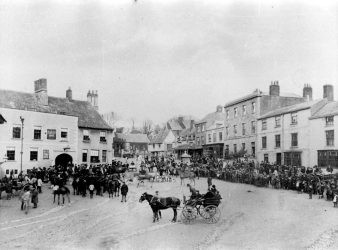
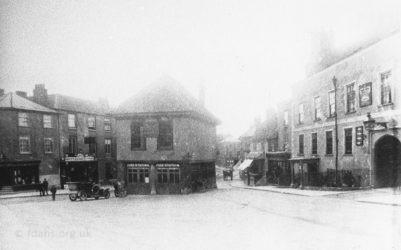
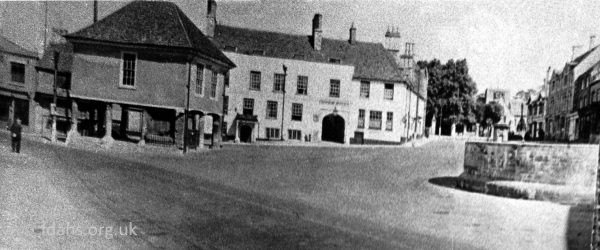
>>> The Market Place from the 1950s
See Market Place Shops & Businesses for a brief history of occupation
See More Photographs & Further Details
See Advertisements in local media
See Faringdon – The Market 18/1900s
See Faringdon Streets for an indexed list of all streets in Faringdon.
References:
- The Changing Faces of Faringdon and Surrounding Villages – Bk1-3. By Rosemary Church, Jim Brown, Millie Bryan and Beryl Newman. Robert Boyd Publications.
- Faringdon Folly, November 1989, p9 – article by Jim Brown – Faringdon Folly November 1989 (pdf)
Researched by Ian Lee, December 2019.
